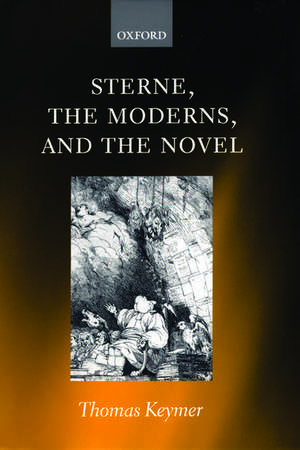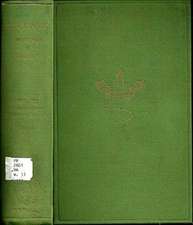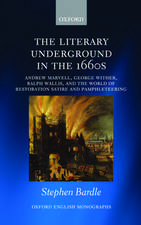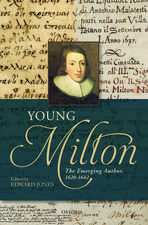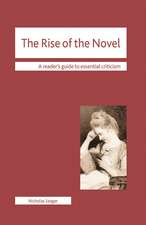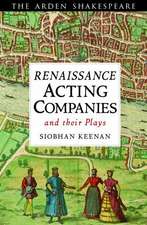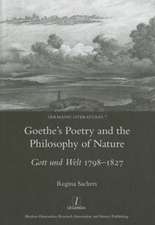Sterne, the Moderns, and the Novel
Autor Thomas Keymeren Limba Engleză Hardback – 21 noi 2002
Preț: 1078.40 lei
Preț vechi: 1642.68 lei
-34% Nou
Puncte Express: 1618
Preț estimativ în valută:
206.36€ • 213.21$ • 171.66£
206.36€ • 213.21$ • 171.66£
Carte tipărită la comandă
Livrare economică 08-14 martie
Preluare comenzi: 021 569.72.76
Specificații
ISBN-13: 9780199245925
ISBN-10: 0199245924
Pagini: 236
Ilustrații: 3pp halftones
Dimensiuni: 144 x 224 x 18 mm
Greutate: 0.4 kg
Editura: OUP OXFORD
Colecția OUP Oxford
Locul publicării:Oxford, United Kingdom
ISBN-10: 0199245924
Pagini: 236
Ilustrații: 3pp halftones
Dimensiuni: 144 x 224 x 18 mm
Greutate: 0.4 kg
Editura: OUP OXFORD
Colecția OUP Oxford
Locul publicării:Oxford, United Kingdom
Recenzii
The many insights of this book's particular readings are fascinating and will doubtless provoke and encourage new work on Tristram Shandy.
Keymer's book, in short, is something of a wonder, a sharply original and consistently eye-opening and provocative rereading of a novel that I thought I knew pretty well ... Keymer opens a substantially new understanding of Sterne as first and foremost an eighteenth-century writer. He has reinstated Sterne as a man of his complicated historical moment.
... high standards of insight and originality characterize this book.
... steady brilliance and exemplary historical scholarship.
Keymer has a wonderful sense of the shape and swing of novelistic production in these decades, and his achievement is to locate Sterne's novel squarely within that field, to trace its targets and to chart its origins and its transformation of those aims and sources.
As well as by scholars of Sterne and of mid-eighteenth-century British culture, the study should also be warmly welcomed by readers interested in the early history of the novel; the available scholarship on which tends to cut out at mid-century, with just the occasional, uneasy glance towards Sterne.
With a tremendous sureness of touch, Keymer has produced a substantial contextual analysis which incorporates important new accounts of the contexts themselves: experimental fiction of the 1750s; the early history of serial publication; literary vogues of the 1760s. For the reader familiar with the essays and articles in which he has explored some of these themes over the last decade, not least among the pleasures of Keymer's book is the seamless manner in which it ties together these apparently disparate concerns.
... an impressively detailed, richly illuminating study.
Keymer's own study makes a detailed and compelling case for viewing Tristram within the culture of its 'immediate day', and as a text 'profoundly of its time'.
Keymer resists conclusions; indeed, the ends of his chapters tend to anticipate the next rather than rounding things up. This open-endedness is a manifestation of Keymer's stimulating open-mindedness and quite appropriate for his subject.
Keymer's treatment of time in the novel is brilliant ... Keymer is to be congratulated on an innovative and engrossing study.
...a gift for beautiful and sharply observant prose, and more than that, a quickness of intelligence that illuminates everything he touches on.
Keymer deepens our understanding both of the ways in which Sterne's experiments with novelistic resources are grounded in mid-eighteenth-century conventions and tropes and of how Sterne appeals far beyond the eighteenth century to our own absorption in the problems of representation and indeterminacy. In its breadth, elegance, and economy this is exemplary work.
Keymer's book, in short, is something of a wonder, a sharply original and consistently eye-opening and provocative rereading of a novel that I thought I knew pretty well ... Keymer opens a substantially new understanding of Sterne as first and foremost an eighteenth-century writer. He has reinstated Sterne as a man of his complicated historical moment.
... high standards of insight and originality characterize this book.
... steady brilliance and exemplary historical scholarship.
Keymer has a wonderful sense of the shape and swing of novelistic production in these decades, and his achievement is to locate Sterne's novel squarely within that field, to trace its targets and to chart its origins and its transformation of those aims and sources.
As well as by scholars of Sterne and of mid-eighteenth-century British culture, the study should also be warmly welcomed by readers interested in the early history of the novel; the available scholarship on which tends to cut out at mid-century, with just the occasional, uneasy glance towards Sterne.
With a tremendous sureness of touch, Keymer has produced a substantial contextual analysis which incorporates important new accounts of the contexts themselves: experimental fiction of the 1750s; the early history of serial publication; literary vogues of the 1760s. For the reader familiar with the essays and articles in which he has explored some of these themes over the last decade, not least among the pleasures of Keymer's book is the seamless manner in which it ties together these apparently disparate concerns.
... an impressively detailed, richly illuminating study.
Keymer's own study makes a detailed and compelling case for viewing Tristram within the culture of its 'immediate day', and as a text 'profoundly of its time'.
Keymer resists conclusions; indeed, the ends of his chapters tend to anticipate the next rather than rounding things up. This open-endedness is a manifestation of Keymer's stimulating open-mindedness and quite appropriate for his subject.
Keymer's treatment of time in the novel is brilliant ... Keymer is to be congratulated on an innovative and engrossing study.
...a gift for beautiful and sharply observant prose, and more than that, a quickness of intelligence that illuminates everything he touches on.
Keymer deepens our understanding both of the ways in which Sterne's experiments with novelistic resources are grounded in mid-eighteenth-century conventions and tropes and of how Sterne appeals far beyond the eighteenth century to our own absorption in the problems of representation and indeterminacy. In its breadth, elegance, and economy this is exemplary work.
Notă biografică
Thomas Keymer is Elmore Fellow and Tutor in English at St Anne's College, Oxford and Lecturer in English Language and Literature, University of Oxford. He is the author of Richardson's Clarissa and the Eighteenth-Century Reader (CUP 1992); editor of Laurence Sterne's A Sentimental Journey and Other Writings (Everyman 1994), Henry Fielding's The Journal of a Voyage to Lisbon (Penguin 1996); and co-editor of the six volumes of The Pamela Controversy: Criticisms and Adaptations of Samuel Richardson's Pamela, 1740-1750 (Pickering and Chatto 2001), Samuel Richardson's Pamela; or, Virtue Rewarded (World's Classics 2001), Henry Fielding's Joseph Andrews and Shamela (World's Classics 1999), and volume 1 of Prefaces, Postscripts, and Related Writings of Samuel Richardson (Pickering and Chatto 1998).
